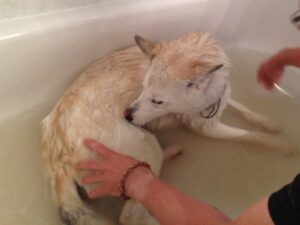OK, you’ve figured out your dog has allergies. The itching, the hair loss, the rashes and infections… so what now?
Whatever the cause of the allergic symptoms, we want to give our poor itchy and rashy friends some relief from their symptoms. Here are some tips:
Cleanliness is our friend
- Bathing can remove allergens such as pollen and spores from the surface of the skin – if your pet has an “allergic season”, bathe more often for that time. If you are bathing more often than every 2 weeks, though, be sure to use a conditioner too to replace some of the natural coat oils you are removing.

- De-greasing shampoos are really useful if the allergic response causes an imbalance in the oil production.
- Ear cleaning! Don’t let the “incubator” of the ear canal build up a head of steam. Keeping the ear canal cool, dry, and closer to its natural acid environment prevents the overgrowth of problematic yeast and bacteria.
Fortify the Barrier Layer
Also working from the outside, in… “spot-ons” are designed to get the outer layer of the skin in better shape. They have special blends of fatty acids that diffuse across the skin, leading to:
- a better barrier – the oils “caulk up” the chinks between the surface skin cells, so there is less exposure of surface allergens to the immune cells deeper in the skin layer.
- moisture retention – the “itch sensors” are less active when the skin has a good moisture level.
Omega-3 fatty acids
The signal chemicals that coordinate the allergic response are all made out of fatty acids. If we keep the enzymes that produce them busy with a certain type of fatty acids, called omega-3s, these enzymes end up making signals that are less itch and inflammation producing. This means that the same allergen exposure produces less reaction than before.
The most important omega-3s out of fish oil are EPA and DHA – add these together to get how many milligrams you are giving (eg EPA 180 mg plus DHA 120 mg is 300 mg).
The omega-3 called GLA is valuable in managing inflammatory skin disease – it is present in flaxseed oil, evening primrose oil, and black currant oil.
Aim for doses of at least 50 mg per kg of body weight per day (doses can go as high as 250 mg/kg/day)
Over-the-counter Medications: Anti-histamines
The main signal chemical in an allergic response is histamine; anti-histamines block its effect. You may have to try more than one before you find which works best in an individual. Diphenhydramine (eg Benadryl) has a higher efficacy than some, but only lasts 8-12 hours and can cause drowsiness (not bad if your dog is scratching himself silly at night!)
There are also non-drowsy once-a-day anti-histamines such as Loratidine (eg Claritin) and Cetirizine (eg Reactine).
Meds like these can be helpful to get through a seasonal allergy peak time or a food allergy flare-up – talk to your vet about dosages.
Prescription Medications
- Corticosteroids – these work really well, because they down-regulate the signals that get the allergic process going; BUT they are associated with a lot of side-effects. Definitely a case of “less is more” – use them only for a short time if you can, and if you can’t then taper down to the lowest dose that still helps.
- Immune Suppressors – these are the same class of drugs used to prevent the immune system from rejecting a transplanted organ, or from fighting against its own tissues (auto-immune disease). Allergies are just another example of the immune system attacking what it shouldn’t. Medications such as Cyclosporin (eg Atopica) are effective, but take a few weeks to build to full effect and can be pricy.
- Something new: Apoquel (not in Canada yet). I have not had a chance yet to try this, but the promise it brings is exciting. It inhibits the signal molecules of the allergic response, without messing up other aspects of the immune response like an immune suppressor would do.
